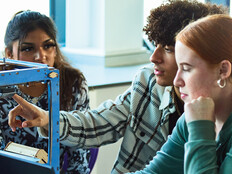K–12 Education’s Top Tech Hurdles to Innovation
Technology is developing at a faster clip than its adoption, and while some K–12 classrooms are innovating — by using drones in curriculum or digital tools to personalize learning — they remain isolated examples dotting an unequal landscape where, often, digitization is seen as an end in itself rather than a means to improve learning.
A recent report from the Consortium for School Networking (CoSN) identified five key roadblocks for K–12 schools’ digital transformation in 2020. Two of the top hurdles are the gap between technology and learning techniques, and a lack of foresight in considering how technologies on the horizon will impact teaching, learning and the world that awaits students after graduation. Three other barriers — scaling and sustaining innovation; instituting ongoing professional technology training; and digital equity — are related to these top hurdles.
MORE FROM EDTECH: Schools Use Immersive Technology for Assistive Learning
Tech for Tech’s Sake Doesn’t Work
The gap between technology and pedagogy begins before technology gets to the classroom, according to CoSN’s report. There’s a lack of collaboration between school educators, administrators, IT staff and students, and this affects decisions about purchasing and implementation. A cohesive strategy and innovative implementation of technology can provide a solution.
“The pursuit of the ‘next new thing’ in technology can take precedence over teaching and learning. That’s backwards,” notes the CoSN report. “Defining the knowledge and skills students need to succeed in a digital world, establishing a shared vision of curricular and pedagogical approaches, and developing a strategic plan should precede and then inform technology decisions that prioritize educational value.”
For example, the report notes an interesting project in Albemarle County Public Schools in Virginia. The county opened an “unschool” for high school students in the 2018–19 school year but purchased no equipment until students arrived. Students decided what they needed for their projects, and only then were buying decisions made.
Similarly, Farmington Area Public Schools in Minnesota developed a community-driven technology implementation plan, made every student the agent of his or her own learning and let students set their own pace. This resulted in more hands-on, project-based learning. The district also empowered each school and its teachers to create a science lab or a media center and equip that space with the technology they wanted to use, rather than taking a top-down approach.
MORE FROM EDTECH: How Educational AI is Making the Grade
Teachers, School Leaders Should be Continuously Trained
Continuous professional development is key to supporting this approach and should include training for teachers, district leaders, principals, coaches and other staff.
“Continuing advances in technology create disconnects between the needs of students and the skill sets of teachers. Technology can accelerate teaching practices — good or bad — and necessitate instructional shifts to effectively support improved student learning,” the CoSN report states.
This continuous updating of skills will also address another key hurdle: how to align what students learn with new technologies that will shape the future of the workplace. In fact, one educator quoted in CoSN’s report said this barrier “sits above almost all of our other hurdles” because statistics show that up to 50 percent of jobs will be transformed by the time today’s K–12 students graduate from high school.
“Artificial intelligence, ‘deep learning’ and robotics are among the game-changing technologies that are beginning to alter the nature of work and workforce demands. While schools clearly face many hurdles in preparing students with skills they need to succeed today, emerging technologies could bring even steeper challenges for educators,” notes CoSN.
Some schools recognize this and are using drones as an educational tool for problem solving and to bring STEM curricula to life. For example, Jersey City (N.J.) Public Schools Division B uses drones to teach a class of elementary students with autism, and another district near Pittsburgh employs drones to hone programing skills — all with encouraging results.
“We’re missing a great opportunity if we don’t make the connection between the evolving role of robotics and AI as a factor on the opportunities for future learners. We need to make a real-world connection for learners,” said Norton Gusky, co-chair of CoSN’s emerging technologies committee.








